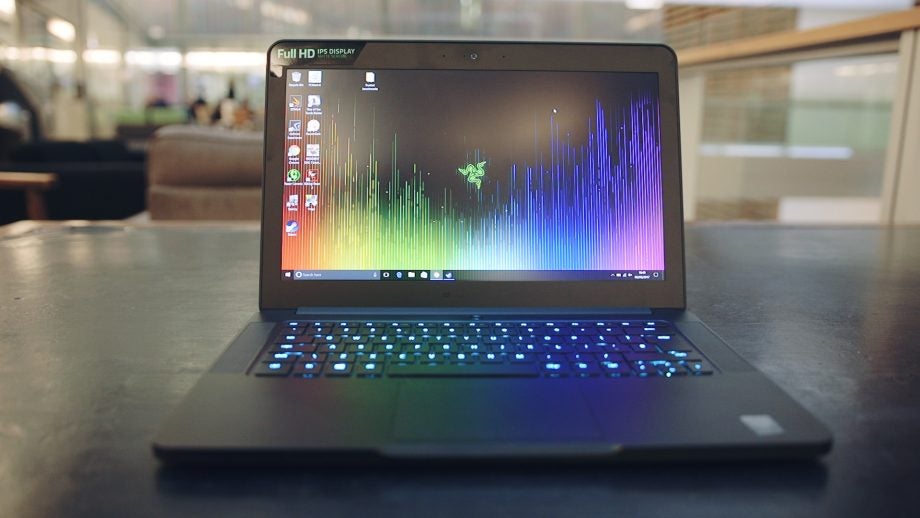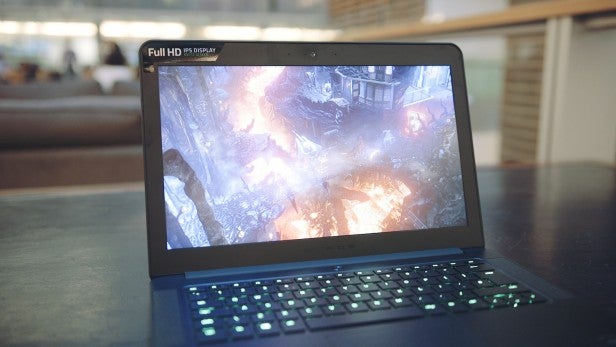Razer Blade Review - Performance, battery and conclusion Review
Performance, battery and conclusion
Another excellent thin and light gaming machine

Sections
- Page 1 Razer Blade Review
- Page 2 Performance, battery and conclusion Review
Razer Blade – Performance
The Razer Blade I reviewed comes equipped with an Nvidia GeForce GTX 1060 GPU with 6GB of GDDR5 memory, a sixth-gen Intel Core i7-6700HQ CPU and 16GB of DDR4 RAM running at 2,133MHz. It also came loaded with a 1TB PCI- Express M.2 SSD; users can also opt for cheaper 256GB or 512GB versions.
This week, Razer launched a newer version of this machine that uses a newer, 7th-gen Intel Core i7-7700HQ processor along with faster DDR4 memory running at 2,400MHz. I’ll update this review with the newer version’s performance benchmarks when I get my hands on one.
Watch: Razer Blade versus Dell XPS 15 and MacBook Pro
The configuration tested is identical to the Gigabyte Aero 14, which is currently the Blade’s closest rival. Running it through TrustedReview’s standard suite of synthetic benchmarks, the Blade fell very slightly behind.
In the CPU-focused Geekbench 4 test, the Blade ran in with a single-core score of 4,094 and a multi-core score of 12,442. By comparison, the Gigabyte Aero 14 scored 4,229 and 12,903 running the same test.
Things got a little more competitive in the gaming benchmarks. The Blade achieved an average frame rate of 65.9fps in the Rise of Tomb Raider’s benchmark, with the graphics settings maxed in 1080p. This puts it a fraction behind the Aero 14, which ran the same test at 68.9fps. But it performed marginally better in Middle-earth: Shadow of Mordor, which ran at 94.7fps at its highest graphics settings in 1080p. The Aero 14 ran the test at a slightly slower 90.8fps.
The Blade completely wiped the floor with the Gigabyte when it came to SSD read/write speeds, however. On AS SSD, the Blade achieved read speeds of 2,541MB/sec and write speeds of 356MB/sec. The Aero 14 ran in with 1,790MB/sec read and 250MB/sec write speeds in the same test.
In the real world, I found that the Blade is more than fast enough for 1080p gaming. With Tomb Raider at its highest preset in 1080p, the game floated between 52-60fps. Killing Floor 2 was similarly smooth at around the 62fps mark at its highest graphics settings in 1080p. It was a similar story in Resident Evil 7, where the Blade easily managed 60fps at its highest setting in 1080p.
The cooling fans did begin to create a minor cacophony during prolonged sessions, but the resulting noise was no worse that the Aero 14, and noticeably quieter than competing gaming laptops such as the MSI GS43VR Phantom Pro.
The bottom of the laptop did become noticeably hot, but never to the point that it felt like it was melting my lap. In general, the GPU never once came close to hitting the dangerous 90 degrees.
In addition, the laptop was more than good enough to run the Oculus Rift – although getting exact benchmarks for VR gaming is tricky, so I can’t comment in detail on its performance running virtual-reality games.
Related: Best gaming mice

Razer Blade – Audio
The Blade’s fan noise wasn’t too big of an issue thanks to the system’s solid stereo speakers. They aren’t going to match a dedicated sound system, headphones or even a decent gaming headset, but they’re more than good enough for regular gaming.
Maximum volume is easily high enough to drown out fan noise, and they manage to remain surprisingly free of distortion and noise at such volumes. Highs are reasonably well handled, and I didn’t experience any of the acidic quality presented by some cheaper laptop speakers. This was particularly noticeable when play Resident Evil 7, where sounds are deliberately harsh and designed to be jarring. Bass levels are more than good enough to make explosions and gunfire sound authentic in game, although a proper gaming headset will always be a better option.
Razer Blade – Battery Life
Battery life on gaming laptops has traditionally been dire. However, recent improvements to the GPU and CPU’s power efficiency has helped change this. As a result, many gaming laptops, such as the competing Aero 14, can survive as much as six or seven hours from a single charge, which is about as much as most regular users need.
Sadly, the Blade doesn’t follow this trend. Its 70Wh battery regularly struggles to last longer the three-to-four hours, even when doing basic tasks, such as word processing and web browsing.
Using the Blade as my laptop, the device never once managed to make it past 2pm; I began using it for work at 9.30am. Gaming when off the mains makes matters worse: I never once managed to get more than two hours playtime out of it.
The same rang true when running TrustedReviews’ synthetic battery test, which loops 10 minutes of web browsing and five minutes of video playback using Powermark with the screen brightness at 150 nits. Here, the Blade managed an average of four hours, which is below average.
Related: Best gaming laptops
Should I buy the Razer Blade?
If you’re on the market for a gaming laptop that can easily be carted around then the Razer Blade is a great machine. The compact, lightweight design is one of the best I’ve seen and looks far more attractive than competing gaming laptops. The addition of a Thunderbolt 3 port is also sets it apart from the majority of mobile gaming rigs.
The only issue is its price. With the cheapest configuration costing a hefty £1,799.99, there are better value options out there. The Gigabyte Aero 14 isn’t as appealing to the eye, but outside of the absence of a Thunderbolt 3 port it has close to identical specs, offers superior battery life and more storage, and is at least £100 cheaper.
People on the market for an Ultrabook, or Windows-flavoured MacBook Pro rival, have plenty of options. For example, the Dell XPS 15 doesn’t match the Blade for graphical grunt, but it’s cheaper, lighter and, if you go for the GTX 1050 option, is more than good enough for video editing and lightweight gaming.
Verdict
A fantastic portable gaming laptop with some very strong rivals.
How we test laptops
Unlike other sites, we test every laptop we review thoroughly over an extended period of time. We use industry standard tests to compare features properly. We’ll always tell you what we find. We never, ever, accept money to review a product.
Trusted Score
Score in detail
-
Performance 9
-
Keyboard 7
-
Design 8
-
Screen Quality 8
-
Build Quality 9
-
Value 7
-
Touchpad 7
-
Heat & Noise 7
-
Battery Life 6



